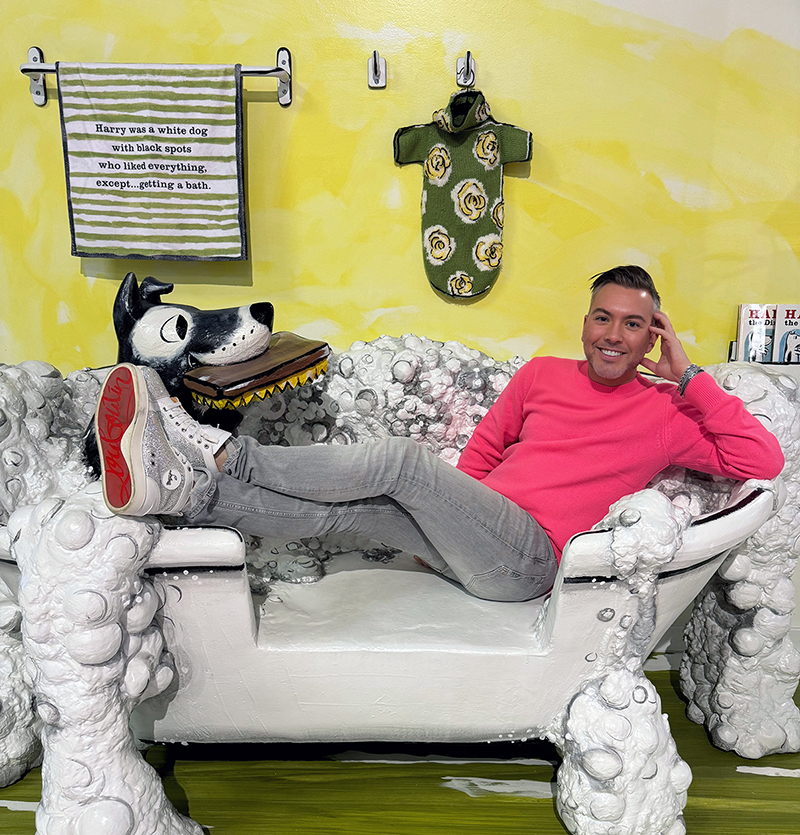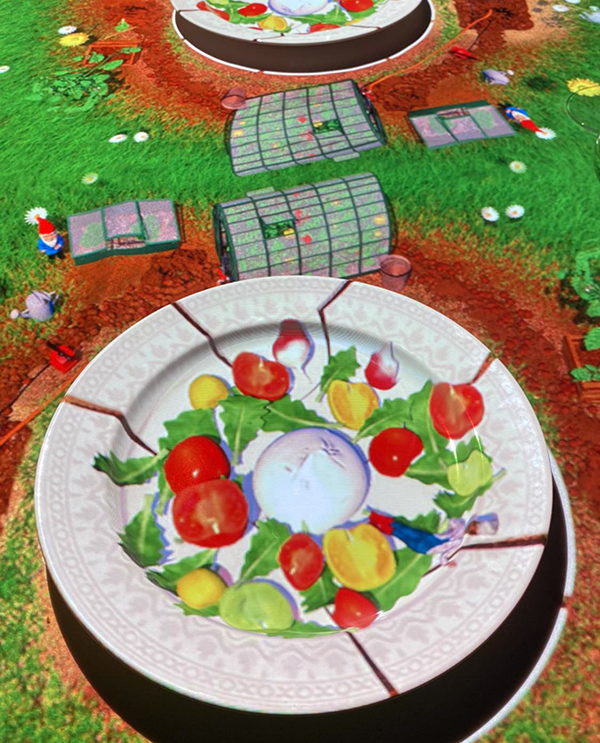
Down the Rabbit Hole
For years, I have been following a certain Instagram account in eager anticipation of the day I might experience the magic it whispered—in person. Thus, I was beyond thrilled to take an early stroll through The Rabbit hOle.
The Rabbit hOle is an immersive, interactive children’s literary museum. Discretely contained within an unassuming 150,000-square-foot former warehouse in North Kansas City, its spectacularity lies inside. One begins in a winding, grotto-like canyon filled with explorer-worthy nooks and caverns where little ones can roam wild. Petrified books and embedded brass letters curiously weave famous book passages into the cave landscape. Together, they beckon you toward an Alice-esque rabbit hole. Its gently glowing blue veins invite you to tumble in.
On the other side, you’ll find yourself in a fantastical world built around 100 years of acclaimed children’s literature by American authors. Suddenly, you’re overwhelmed with fragmented memories of childhood story time or trips to the school library that all begin falling into place. Emerging from underground, you spot Madeline overhead. She’s famously leading a row of yellow-clad classmates as they teeter along the Seine, with Miss Clavel trailing—aghast. Babar and his elephant friends are flying overhead. Kids are sliding down the firepole inside The Fire Cat fire station. The most stunning hand-fabricated carousel of tigers from Sam & the Tigers is a sight to behold (and ride). There are interactive moments from so many other favorites, including Strega Nona, Caps for Sale, I am a Bunny, and Curious George. The kitchen from Blueberries for Sal invites you to examine every detail, including the hand-painted “dish towels” hanging from the wall. And from one of my most beloved childhood authors, Shel Silverstein, Where the Sidewalk Ends lures little ones to climb inside the mouth of its boa constrictor. For those scenes you don’t recognize, nearby books provide answers and endless opportunities for impromptu story time.
Everything is dazzling, whimsical, and enchanting.
From the main museum, you’re dropped out at—where else, the gift shop. Rather, it’s The Lucky Rabbit Bookstore. In addition to the wide array of classic children’s books, there will be a steady schedule of traditional bookstore programming, including story times, baby music times, book clubs, craft workshops, and author events. The bookstore is also open to the public, not requiring an admission ticket. Want a unique spot to curl up with the book you just purchased? Why not step into the incredible Goodnight Moon room, which is the timeless story brought to technicolor life—complete with a crackling fireplace, glowing moon, and a bedside telephone whose receiver plays a special recording of the author’s son reading the book.
Overheard: “Stop trying to make ‘Are you yoking me?’ happen.”
The wildly ambitious $20 million project—fueled by an early $2 million gift from the Royals principal owners John and Marny Sherman—has been eight years in the making. And, while finally open, they’re not finished dreaming. In addition to the 45 existing literature vignettes, they currently have rights to more than 70 (no other museum in the world can boast anything close to this). And with two more floors waiting to be filled, there’s room to think big. Coming soon are also a print shop and story lab, a maker space, a resource library, and a discovery gallery for original book art. Nearly finished, is an “automat café” that will offer book-inspired treats—made fresh, but dispensed via a vending machine-like operation. No doubt it will be inventive and charming.
The museum will hold its grand opening celebration—The Fox Rabbit Spectacular—on Saturday, April 27. The day will include special author guests, music, crafts, and food trucks. It’s daunting to convey how special this place feels and the loving craftsmanship and imaginative fabrication that went into it. I hope you’ll experience it—with wonder and joy—for yourself.
Hot Gossip: Who took a friend group to the casino for dinner, courtesy of hard-won credits?

Make it Petit
I recently had the pleasure of dinner prepared by “the world’s smallest chef.” Thanks to an invitation from my friend Susu McMeel, I relished this unique and entirely unconventional meal with her and her lovely daughter, Mary Kate, at the downtown Hotel Phillips.
Le Petit Chef is an immersive, animated, pop-up dining experience. Using sophisticated 3-D mapping technology and overhead projectors, diners can follow this adorable little (digital) chef as he industriously prepares a five-course dinner. Throughout the experience, the entire table is transformed into a virtual prep station that adapts based on each course.
For the burrata starter, we followed chef as he plucked basil, arugula, and tomatoes from nearby garden plots and a greenhouse. Butterflies simultaneously dancing on our plates and lively garden gnomes meant there was always something to capture our attention. Our eyes were always scanning the tablescape to see what would happen next. For the bouillabaisse, the chef fished mussels and clams right out of the rippling ocean, dunking them into the boiling pot that was our plate. A curious, writhing octopus tentacle was lobbed off and tossed in as well. For the chicken course, a Cornish hen was roasted on a campground rotisserie as the chef foraged for green beans and carrots. Those veggies were plunked into an ingeniously dammed stream and brought to a boil with the clever use of a magnifying glass. Our 12-ounce KC Strip sizzled with broccolini and fingerling potatoes on a charcoal grill atop a gingham picnic tablecloth. For dessert, there was vanilla crème brûlée, with its crispy sugar coating torched by the chef’s own fire breathing.
Overheard: “I’ll see you when we land. It’s too bad you’re behind the curtain.”
Following each augmented reality-course presentation, the digital plate is replaced by a real-food version via waiters on hand for the perfectly timed drop. Because, you know, bits and bytes won’t fill your tummy.
While chef grunts and laughs, he doesn’t speak—meaning, there’s no language barrier for enjoying this meal. There’s the classic menu, as well as a vegetarian and children’s menu. The dinner takes roughly 90 minutes, and in-between courses, the chef disappears, so there’s plenty of time to converse with your dining companions. While we grown-ups found the experience to be adorable, fun, and entirely satisfying, I can only imagine that smaller children would be floored with rollicking amusement.
The Petit Chef concept began in Germany and has become a global phenomenon. The reservations site offered options in Dubai, Paris, Seoul, Bali, and Istanbul, among 60 or so other cities. When we visited, there was just one U.S. location. Aren’t we special? Finally—as I write—reservations are available in Kansas City through the end of May (and may be extended). So, there’s still time for you to also savor this one-of-a-kind meal.
Hot Gossip: Whose vacation table-dancing left the danseur with multiple broken ribs and a hospital stay?
Cocktails & Couture
This year marks the 75th anniversary of BOTAR in Kansas City. It also poignantly marked attending my first-ever BOTAR event.
BOTAR [Belles of the American Royal] is a women’s leadership organization that supports the mission of the American Royal and its role in promoting the agribusiness economy in Kansas City and the region. BOTAR develops civic involvement and leadership skills through intergenerational mentoring and volunteerism. It serves as a link between Kansas City’s history as a major U.S. livestock market and its future as a global agribusiness center. The not-for-profit organization of 1,200 active members has contributed more than a million dollars to the American Royal—for scholarship and educational programs—through the annual BOTAR Ball.
The Ball—it may be one of Kansas City’s most known and talked about. Each year, a class of young women are presented in custom finery. Initially, each year’s original gown resulted from a ball committee. That committee would perform direct outreach to fashionable stores or designers, soliciting options. Their results were notable. Victor Costa (1974, 1980, 1983), Christian Dior (1992), etc. This responsibility bounced across various committee iterations over the years before finally landing, in 2003, at the hands of the BOTAR President. This also marked when Kansas City designer Mary Neddo took over design and construction responsibilities. She’s designed all gowns since.
To mark this 75th-anniversary occasion, the BOTAR organization held a cocktail party and fashion show at the Grand Ballroom downtown. We nibbled on empanadas, spring rolls, and indulged at a macaroni and cheese bar. But we were mostly there for the fashions. Archived in cold storage at Alaskan Fur, the 75 years’ worth of gowns resurfaced on a massive runway. Organized by decade, we delighted in the changing styles of the times, paired with decade-appropriate hit music. Across the decades there were such clear design-inspiration references. My Fair Lady, Jacqueline Kennedy, Twiggy, Princess Diana . . . It was truly the most incredible frolic through fashion history and could have gone on for hours, as far as I was concerned.
Favorite gowns? Yes, I had a few. My number one, 1968, was a white gown with gold and pearl braided trim around the neckline, an empire waist, and a flat bow on the back. It was almost Grecian. Restrained sophistication. I later learned it was designed (no wonder my gravitation) by Oscar de la Renta. He even attended a BOTAR gala cocktail event that same year. Another favorite was 1971. It was the first black BOTAR gown—sleeveless, made of silk, with a square neckline and a ruffled slit up the front. It was designed by one of my dearest friends, Dee Dee Arnold, was chic, and has withstood the test of time. Bravo.
One thing that positively floored me was the inability to trot the first two gowns (1949 & 1950) down the runway. Why? They could not find models slim enough to wear them. Imagine! Instead, the gowns graced two mannequins (unzipped) at the event’s entrance. I couldn’t help but wonder if the weight spectrum pendulum has perhaps finally reached its final stretch and, with the trendy use of GLP-1 shots, we’re headed back toward pre-1950? If I’m around for the 100th anniversary runway show, I’ll be sure to take note.
Want to see and read more about this fascinating history of gowns? The BOTARS have published the most beautiful hardcover book, chronicling this history. It’s available on their website. A special thanks to BOTAR President Natalie Kirk Welch, who extended my invitation and had me seated front and center beside her. And a major hat tip to Julie McCann and Missy Schaffer, who did a phenomenal job envisioning this tremendous event and bringing it to vibrant life.
Spotted: Amy Embry, Rachel Sabates, Missy Love, Amy Thompson, Addie Thompson, Lee Page, Deanna Deibolt, Gina Penner, Megan Bubb, Chuck Matney & Todd Holland-Matney, Susan Murphy, Vicky Leonard, Blythe Launder, Blythe Robertson, Mary Ann Powell, Carrie Larson, Stephanie Kissick, Jo Marie Scaglia, Lora Garrison, Heather Bath, Kim Mann, Maddie Mann, Cathy Schultz, Jamie Berg, Mindy Wilson, Julie Mulhern, Daily O’Brien, Shannon O’Brien, Stephanie Freeman, Stacy Scheelk, Mike McCann, Claire McCann, Emily McCann, Silvy Brookby, Kathy Nordhus, Donna Slaughter, Missy & Tim Schaffer, Paula & John Longan


